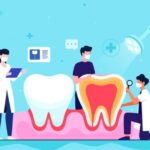
A Visual Guide to Erectile Dysfunction
Creating a visual guide to erectile dysfunction (ED) can help understand the condition and its causes.
Fildena 200 works by inhibiting the enzyme phosphodiesterase type 5 (PDE5) in the smooth muscle cells of the penis. Here’s a breakdown of what such a guide could include:
Erectile Dysfunction:
What erectile dysfunction is (the inability to get or keep an erection firm enough for sexual intercourse).
Highlight how common ED is, affecting men of all ages but more prevalent in older age groups.
Clinical studies have shown that sildenafil, the active ingredient in Sildalist 120, is effective in treating ED in men.
Emphasize the significance of consulting a healthcare professional if experiencing ED, as it could be a symptom of an underlying health condition.
Anatomy of Erection:
Illustration of the male reproductive system, including the penis, testes, and associated structures.
Explanation of how an erection occurs: Blood flow to the penis increases, causing it to become rigid and erect.
Causes of Erectile Dysfunction:
Physical Causes:
Certainly, here’s an expanded section on the risk factors associated with erectile dysfunction (ED):
Age:
- Risk increases with age due to natural physiological changes, such as decreased blood flow to the penis and declining levels of testosterone.
- However, ED is not an inevitable part of aging and can occur at any age.
Medical Conditions:
- Cardiovascular Disease: Conditions like atherosclerosis (hardening of the arteries), hypertension (high blood pressure), and high cholesterol can restrict blood flow to the penis, leading to ED.
- Diabetes: High blood sugar levels can damage blood vessels and nerves, affecting blood flow and causing nerve damage, both of which contribute to ED.
- Neurological Disorders: Conditions such as multiple sclerosis, Parkinson’s disease, and stroke can interfere with nerve signals between the brain and the penis, affecting erectile function.
- Hormonal Imbalances: Low levels of testosterone or high levels of prolactin (a hormone that regulates sexual function) can contribute to ED.
- Obesity: Excess body weight is linked to various health conditions such as diabetes, high blood pressure, and cardiovascular disease, all of which increase the risk of ED.
- Prostate Conditions and Treatments: Enlarged prostate (benign prostatic hyperplasia) and treatments like surgery or radiation therapy for prostate cancer can damage nerves and blood vessels involved in erectile function.
Lifestyle Factors:
- Smoking: Tobacco use damages blood vessels, reducing blood flow to the penis and increasing the risk of ED.
- Alcohol Consumption: Excessive alcohol intake can impair nerve function and decrease testosterone levels, contributing to ED.
- Drug Use: Recreational drugs like cocaine, heroin, and methamphetamines can interfere with erectile function.
- Lack of Physical Activity: A sedentary lifestyle contributes to obesity, cardiovascular disease, and other conditions linked to ED.
- Poor Diet: Diets high in saturated fats, processed foods, and refined sugars are associated with obesity and cardiovascular disease, both of which increase the risk of ED.
- Psychological Factors: Stress, anxiety, depression, and relationship issues can affect sexual desire and performance, contributing to ED.
Medications and Substance Abuse:
- Certain medications, including antidepressants, antihypertensives, antipsychotics, and prostate medications, can have side effects that interfere with erectile function.
- Substance abuse, including tobacco, alcohol, and illicit drugs, can contribute to ED.
Genetics and Family History:
- Genetic predisposition may play a role in susceptibility to conditions like diabetes, cardiovascular disease, and hormonal imbalances, which are risk factors for ED.
- A family history of ED may increase the likelihood of developing the condition.
Psychological Factors:
- Performance anxiety, stress, depression, and relationship problems can all contribute to ED, either as primary factors or exacerbating existing physical causes.
Psychological Causes:
Illustrate stress, anxiety, depression, and relationship issues as potential psychological factors contributing to ED.
Lifestyle Factors:
Visualize how smoking, excessive alcohol consumption, drug use, and lack of exercise can impact erectile function.
Risk Factors:
Age: Illustrate how the risk of ED increases with age due to factors like declining testosterone levels and the accumulation of health conditions.
Medical History: Highlight the risk associated with certain medical conditions and treatments, such as prostate surgery or radiation treatment for cancer.
Treatment Options:
Medications: Illustrate commonly prescribed medications like phosphodiesterase type 5 (PDE5) inhibitors (e.g., Viagra, Cialis) and how they work to improve blood flow to the penis.
Therapies: Show visual representations of treatments such as vacuum erection devices, penile implants, and psychological counseling for ED.
Lifestyle Changes: Highlight the importance of lifestyle modifications such as regular exercise, healthy diet, quitting smoking, and managing stress in managing ED.
Prevention Strategies:
Encourage healthy lifestyle habits to prevent the onset of ED, including regular physical activity, maintaining a healthy weight, avoiding excessive alcohol and tobacco use, and managing stress.
When to See a Doctor:
Provide clear indications of when it’s important to consult a healthcare professional for evaluation and treatment of ED symptoms.
Conclusion:
Encourage open communication with healthcare providers and partners about ED concerns.
Reiterate the importance of seeking timely medical advice for effective management of ED.
Remember, while a visual guide can be informative, it’s essential to consult healthcare professionals for personalized advice and treatment options tailored to individual needs.






Leave Your Comment